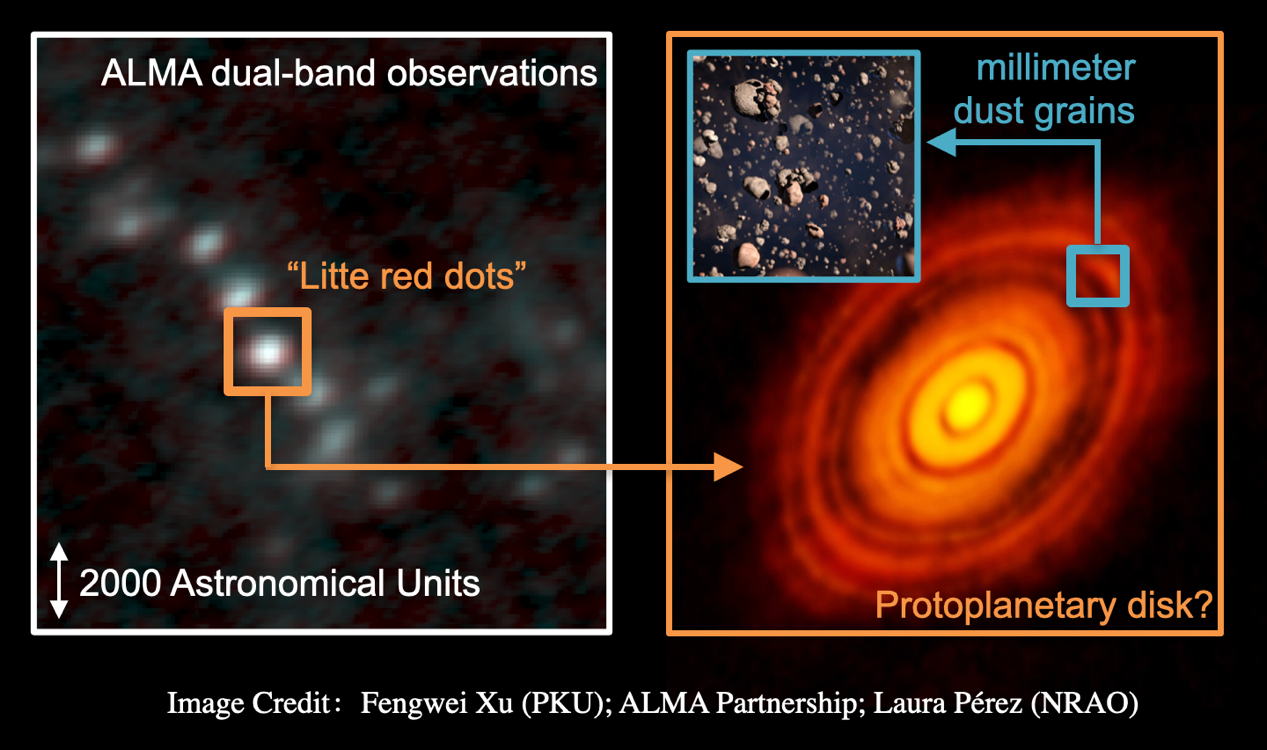Astronomers discover hundreds of protoplanetary disk candidates in the Galactic Center using ALMA's dual-band observations
Are We Alone? And Where Do We Come From? For decades, astronomers have discovered hundreds of protoplanetary disks—structures believed to represent the early stages of our own solar system. However, most of these discoveries lie within our neighborhood, which may not reflect the extreme conditions found in other parts of the Milky Way. Among the most dynamic and turbulent regions is the Central Molecular Zone (CMZ), near the Milky Way Galactic Center, where high pressure and density may shape star and planet formation in fundamentally different ways. Studying protoplanetary systems in the CMZ provides a rare opportunity to test and refine our theories of solar system formation.
An international team of researchers from the Kavli Institute for Astronomy and Astrophysics at Peking University (KIAA, PKU), the Shanghai Astronomical Observatory (SHAO), and the University of Cologne (UoC), along with several collaborating institutions, has conducted the most sensitive, highest-resolution, and most complete survey to date of three representative molecular clouds in the Milky Way’s CMZ. Their observations revealed over 500 dense cores—the sites where stars are being born.
Detecting such systems in the CMZ is exceptionally challenging. These regions are distant, faint, and deeply embedded in thick layers of interstellar dust. To overcome these obstacles, the team utilized the Atacama Large Millimeter/submillimeter Array (ALMA), an interferometric telescope that combines signals from antennas spread over several kilometers to achieve extraordinary angular resolution. This allows astronomers to resolve structures as small as 1000 astronomical units even at CMZ distances of 8.3 kiloparsecs—roughly 17 billion AU away.
By reconfiguring the array and observing at multiple wavelengths, the team performed “dual-band” observations—capturing two different colors of light at the same spatial resolution. Just as human vision relies on color contrast to interpret the world, dual-band imaging provides critical spectral information about the temperature, dust properties, and structure of these remote systems. “Only with ALMA can we open this sharp new window onto one of the most enigmatic regions of our Galaxy,” added Prof. Xing Lu, a researcher at Shanghai Astronomical Observatory and the Principal Investigator of the ALMA observing project.
To their surprise, the researchers found that more than 70% of the dense cores appeared significantly redder than expected. After carefully ruling out observational bias and other possible explanations, they proposed two leading scenarios—both suggesting the widespread presence of protoplanetary disks.
“We were astonished to see these ‘little red dots’ cross the whole molecular clouds,” said Fengwei Xu, the first author of the study and now a PhD student at KIAA, PKU and exchange student at UoC. “They are telling us the hidden nature of dense star-forming cores.”
One possible explanation is that these cores are not transparent, homogeneous spheres as once thought. Instead, they may contain smaller, optically thick structures—possibly protoplanetary disks—whose self-absorption at shorter wavelengths results in the observed reddening. “These challenges our original assumption of canonical dense cores.” said Prof. Ke Wang, Fengwei’s supervisor.
Another possibility involves the growth of dust grains within these systems. “In the diffuse interstellar medium, dust grains are usually just a few microns in size,” explained Prof. Hauyu Baobab Liu, who led the radiative transfer modeling in the study. “But our models indicate that some cores may contain millimeter-sized grains, which could only form in protoplanetary disks and then be expelled—perhaps by protostellar outflows.”
Regardless of which scenario proves dominant, both require the presence of protoplanetary disks. The findings suggest that over 300 such systems may already be forming within just these three CMZ clouds. Future multi-band observations will help to further constrain their physical properties and evolutionary stages—offering a rare glimpse into the early processes that give rise to planetary systems like our own, even in the most extreme corners of the Milky Way.
This work is supported by the National Key R&D Program of China, the Strategic Priority Research Program of the Chinese Academy of Sciences (CAS), the National Natural Science Foundation of China (NSFC), the Natural Science Foundation of Shanghai, the CAS “Light of West China” Program, etc.

Image credit: Fengwei Xu (PKU); ALMA Partnership; Laura Pérez (NRAO).
论文链接:https://www.aanda.org/articles/aa/full_html/2025/05/aa53601-24/aa53601-24.html
Download attachments: